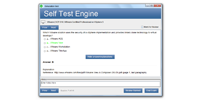あなたのOGEA-103試験合格を100%保証
JPNTestテスト問題集を初めて使用したときにEnterprise Architecture OGEA-103試験(TOGAF Enterprise Architecture Combined Part 1 and Part 2 Exam)に合格されなかった場合は、購入料金を全額ご返金いたします。
JPNTestでThe Open Group OGEA-103問題集をチョイスする理由
JPNTestは、1週間で完璧に認定試験を準備することができる、忙しい受験者に最適な問題集を提供しております。 OGEA-103の問題集は、The Open Groupの専門家チームがベンダーの推奨する授業要綱を深く分析して作成されました。弊社のOGEA-103学習材料を一回のみ使用するだけで、The Open Group認証試験に合格することができます。
OGEA-103はThe Open Groupの重要な認証であり、あなたの専門スキルを試す認定でもあります。受験者は、試験を通じて自分の能力を証明したいと考えています。 JPNTest TOGAF Enterprise Architecture Combined Part 1 and Part 2 Exam は、Enterprise Architectureの122の問題と回答を収集して作成しました。TOGAF Enterprise Architecture Combined Part 1 and Part 2 Examの知識ポイントをカバーし、候補者の能力を強化するように設計されています。 JPNTest OGEA-103受験問題集を使用すると、TOGAF Enterprise Architecture Combined Part 1 and Part 2 Examに簡単に合格し、The Open Group認定を取得して、The Open Groupとしてのキャリアをさらに歩むことができます。
ダウンロード可能なインタラクティブOGEA-103テストエンジン
Enterprise Architectureの基礎準備資料問題集には、Enterprise Architecture OGEA-103試験を受けるために必要なすべての材料が含まれています。詳細は、正確で論理的なものを作成するために業界の経験を常に使用しているEnterprise Architecture によって研究と構成されています。
OGEA-103の迅速なアップデート対応
OGEA-103試験に変更がございました場合は、現在の試験と一致するよう、瞬時に学習資料を更新することができます。弊社は、お客様に最高、最新のThe Open Group OGEA-103問題集を提供することに専念しています。なお、ご購入いただいた製品は365日間無料でアップデートされます。
OGEA-103試験の品質と価値
JPNTestのEnterprise Architecture OGEA-103模擬試験問題集は、認定された対象分野の専門家と公開された作成者のみを使用して、最高の技術精度標準に沿って作成されています。
The Open Group TOGAF Enterprise Architecture Combined Part 1 and Part 2 認定 OGEA-103 試験問題:
1. Complete the sentence. The four purposes that typically frame the planning horizon, depth and breadth of an Architecture Project, and the contents of the EA Repository are Strategy, Portfolio,
A) Project, and Solution Delivery.
B) Discreet, and Cohesive.
C) Segment, and End-to-end Target Architecture.
D) Subordinate, and Superior Architecture.
2. Complete the sentence The Enterprise Continuum provides methods for classifying architecture artifacts as they evolve from________________________.
A) Foundation Architectures to re-usable architecture assets
B) Solutions Architectures to Solution Building Blocks
C) generic architectures to reusable Solution Building Blocks
D) generic architectures to Organization-Specific Architectures
3. Which of the following describes a purpose of Architecture Principles?
A) To describe likely impacts resulting from successful deployment of the target architecture.
B) To establish a common understanding of how to control the business in pursuit of strategic objectives
C) To form a contract between sponsoring organization and the enterprise architects
D) To provide a better understanding about the enterprise's culture and values
4. Complete the sentence A set of architecture principles that cover every situation perceived meets the recommended criteria of_______________
A) stability
B) robustness
C) completeness
D) consistency
5. Consider the following descriptions of deliverables consumed and produced across the TOGAF ADM cycle.
* General rules and guidelines, intended to be enduring and seldom
amended, that inform and support the way in which an organization sets
about fulfilling its mission
* The joint agreements between development partners and sponsors on the deliverables, quality, and fitness-for-purpose of an architecture.
* A document that is sent from the sponsoring organization to the
architecture organization to trigger the start of an architecture
development cycle
* A set of quantitative statements that outline what an implementation
project must do in order to comply with the architecture.
Which deliverables match these descriptions?
A) 1 Architecture Principles -2 Architecture Contracts - 3 Request for Architecture Work - 4 Architecture Requirements Specification
B) 1 Architecture Contracts - 2 Architecture Requirements Specification - 3 Architecture Vision - 4 Architecture Principles
C) 1 Architecture Requirements Specification -2 Architecture Principles - 3 Architecture Vision - 4 Architecture Contracts
D) 1 Architecture Principles -2 Architecture Contracts - 3 Architecture Requirements Specification-4 Request for Architecture Work
質問と回答:
| 質問 # 1 正解: C | 質問 # 2 正解: D | 質問 # 3 正解: B | 質問 # 4 正解: C | 質問 # 5 正解: A |


 284 お客様のコメント
284 お客様のコメント





